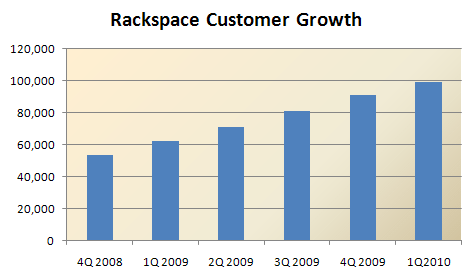
Growth at Rackspace has been fueled by customer interest in its cloud computing services.
Rackspace Hosting ended the first quarter with 99,446 customers, meaning the company has by now easily cleared the 100,000 customer mark. More than 80 percent of those customers are using Rackspace's cloud computing services, a clear sign of the evolution of the company's business beyond its roots in managed hosting.
Rackspace's customer base grew by 8,521 in the first quarter. Virtually all of that growth was in its cloud computing business, which has grown to 80,080 customers and $19.3 million in revenue, up from $17.1 million in the previous quarter. By comparison, the company's managed hosting customer base grew by just 62 customers to 19,366.
But those managed hosting clients generated $159.5 million in revenue, up $7.14 million from the previous quarter. In other words, the managed hosting unit accounted for less than 1 percent of customer growth, but 77 percent of revenue growth.
Hitting its Quarterly Numbers
Rackspace management continues to emphasize the huge opportunity in cloud computing. Even as Rackspace (RAX) continues to hit its quarterly numbers (yesterday's earnings report met Wall Street expectations for both earnings and revenue), analysts are scrutinizing the company's performance as a barometer of what the cloud transition will mean for provider profitability.
During yesterday's earnings conference call, Rackspace executives shared their vision of how cloud computing may evolve, and what it will mean for the company's bottom line.
"There is a tectonic shift underway," said CEO Lanham Napier. "We believe the opportunity in front of us is massive."
Napier said he expects the cloud computing market to diverge into two segments - a commodity cloud segment where customers are focused on pricing, and a service-oriented cloud segment focused on performance.
"Our strategy is to be the leader in that service-oriented sector," said Napier. "Our target market is businesses who are willing to pay for a world-class quality outcome. There is a class of customer out there that wants fanatical support, and is willing to pay for it."
Automation or Customer Service?
Napier acknowledged that many customers view automation, not personal service, as the primary benefit of the cloud computing model. "Cloud represents an on-demand world, where much of the work will be done through a console, and where the customer probably won't want to talk to a Racker," he said, invoking the nickname for Rackspace employees.
But Napier said he believes the cloud model will track the experience with managed hosting, with plenty of room for add-on services as the business model matures. "As cloud continues to develop, new opportunities will present themselves," he said, adding that Rackspace has services in development that will be attractive to customers and boost margins in the cloud operation.
Revenue Per Server
Rackspace has previously emphasized the use of revenue per server as a better measure of the value of its cloud computing business than the traditional hosting metric of average revenue per user (ARPU). Rackspace added 3,205 customer servers in the first quarter, ending with 59,876. The company's revenue per server slipped slightly from $2,992 to $2,986 (see chart below).
CFO Bruce Knooihuizen said the enterprise transition to the cloud will develop over time - as will the benefits for Rackspace's bottom line.
"Our expectation is that we'll get margins that are similar and a return on capital that's even better than in the managed hosting business," said Knooihuizen. "Whether that takes three or four years to get there depends on the growth of the market. From the standpoint of profitability and return on capital, we love the cloud business."





